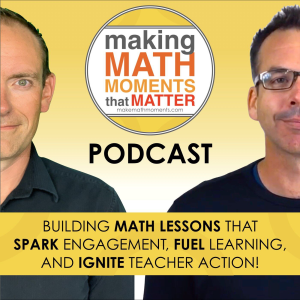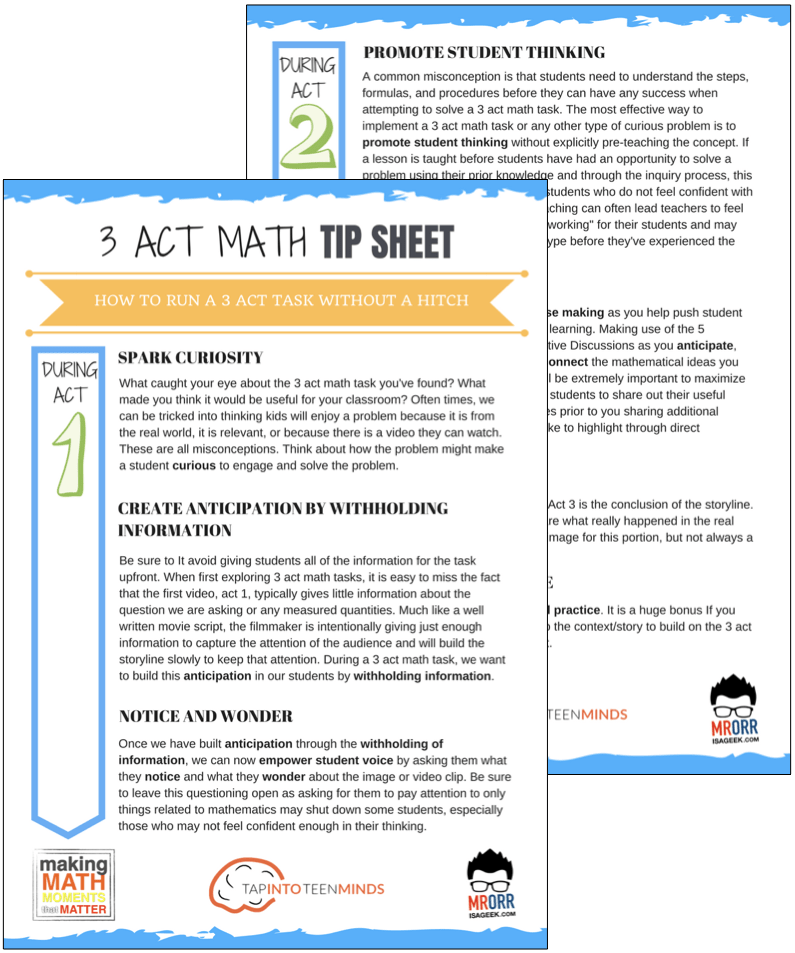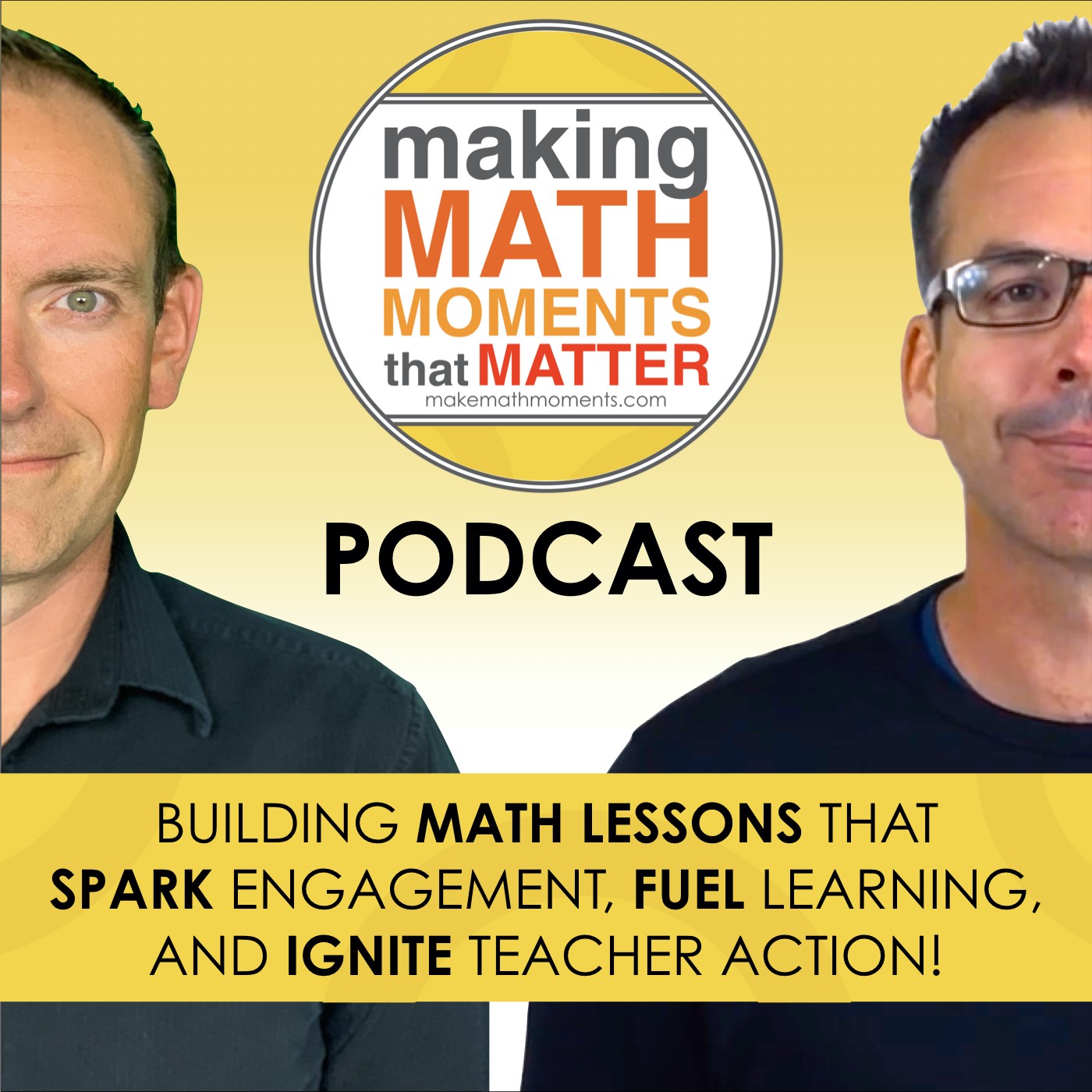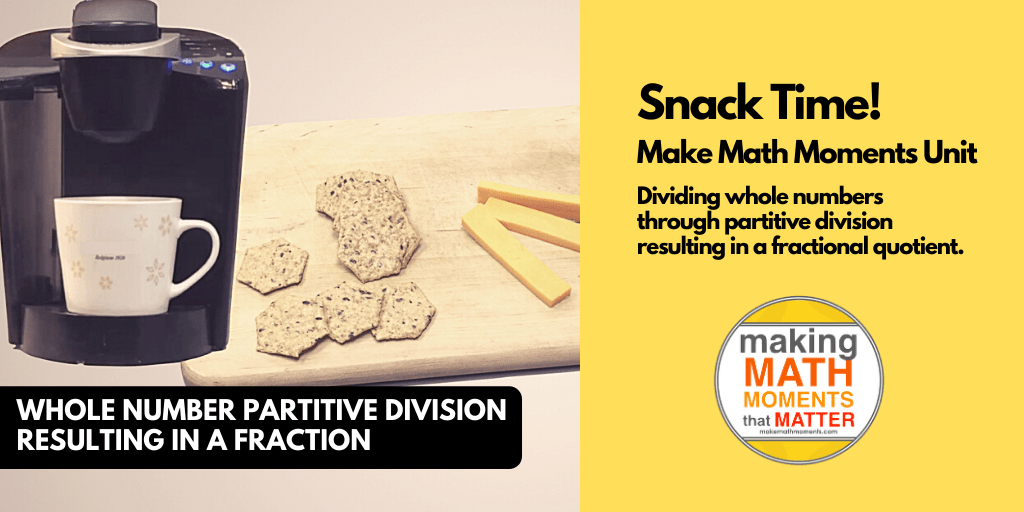Episode #324: How to Re-frame Support To Increase Strategy Adoption in Math | Math Coaching & Training
LISTEN NOW HERE…
OR JUMP TO YOUR FAVOURITE PLATFORM
WATCH NOW…
Episode Summary:
Why do so many professional development plans flop? Because they’re trying to fix the wrong problem.
Are you struggling to get teachers on board with new strategies in their classrooms when teaching mathematics?
In this episode, we tackle the disconnect between professional development initiatives in the area of math and the real challenges teachers face, breaking down why adoption often falls short and how to bridge that gap effectively.
- Discover the “Five Stages of Awareness” framework for math strategy adoption to better support teachers in their journey toward adopting impactful strategies.
- Learn how to uncover the “pebbles in teachers’ shoes” and position your solutions as the answer to their most pressing problems when teaching math.
- Gain actionable insights into aligning professional development with your district’s key math objectives for sustainable and measurable results.
Tune in now to revolutionize how you support teachers and ensure meaningful progress in your math programs this year!
Attention District Math Leaders:
Not sure what matters most when designing math improvement plans? Take this assessment and get a free customized report: https://makemathmoments.com/grow/
Ready to design your math improvement plan with guidance, support and using structure? Learn how to follow our 4 stage process. https://growyourmathprogram.com
Looking to supplement your curriculum with problem based lessons and units? Make Math Moments Problem Based Lessons & Units
Be Our Next Podcast Guest!
Join as an Interview Guest or on a Mentoring Moment Call

Apply to be a Featured Interview Guest
Book a Mentoring Moment Coaching Call
Are You an Official Math Moment Maker?

FULL TRANSCRIPT
It’s likely you are trying to solve a problem that the teacher you’re working with doesn’t actually have. One of the most common questions we get asked here at Make Math Moments when we work with schools, school districts, district coordinators, is how do we help teachers adopt new teaching strategies? How do we create buy-in? And I think it comes down to thinking about what problems are teachers experiencing?
and what solutions are you trying to provide? And oftentimes there’s a mismatch there. And I want to address that mismatch here in this particular video. And I want to share this idea that has been floating around my mind and around the of awareness. The stages of awareness are when you have to think about that…
Every teacher goes through stages of awareness when they have problems and seeking the solutions to those problems. When we’re trying to help teachers adopt new strategies, we’re actually trying to provide implementation on a problem. That’s maybe in the classroom. So we just got off the call from one of our congestion coordinators and one of their objectives this year is discourse in the classroom. More discourse as a general theme, as a general zone to strengthen.
in the classrooms across the district and their math math programs from K to 12. And when you think about trying to support discourse in the classroom, we’re actually trying to say these are the routines. These are the structures. These are the ideas. These are the lessons. This is the way you want to design your lesson. Like you’re you’re you’re giving teachers structural routines and pedagogical moves to solve a problem. And that problem you’re trying to identify is that there needs to be more discourse in the classroom. Teach kids kids.
are going to learn their mathematics at a deeper level. If they are sharing their ideas, communicating their ideas, you’re going to learn more about what they are, where they are in their learning journey, which is assessment for you as a teacher, so that you can provide the next steps for them. Which is really important components of why discourse is important. There’s no doubt about it that that’s a valid and a worthwhile zone or area to strengthen across say a mathematics program.
Where we see some disconnect is that, you know, even though you may have said discourse is an issue you see in classrooms, it’s not likely that the teacher that you may be trying to convince or trying to adopt that strategy or these routines, they see them as that as a solution to a problem they have. So here are the five stages of awareness. The first stage anyone is, and when they’re looking for a particular solution is the…
is the first stage is people are unaware. They’re unaware that there is an even, there is a problem at all. And so that’s the unaware stage. So when you’re thinking about it is like, can imagine teachers right now is that you go in and ask them a question about like, what are the pebbles in your shoe? And my teacher might say like, I don’t really have any, like everything’s running the way they would like. The classroom is working well. You might not find, you know, a teacher who does say that, I’m sure that there are many problems that teachers are going to say, but.
When you think about, say, discourse or the solution that you want to provide, they’re unaware that there’s a problem in that area. They don’t think that that’s the problem. They’re in the unaware stage. And when we think about providing professional development around, say, this zone and supporting teachers to adopt strategies,
We’re trying to maybe solve the problem that they’re in. And when they’re in the unaware stage, this is where teachers are tuning out or this is where teachers are like, this is not something that solves my immediate problems. They have different problems and you may have not presented this strategy or adoption or routine as a solution to a problem they have, which is a major concern, a major problem of why you’re not seeing adoption is because they’re not seeing as the solution that you have.
as a solution to any of their current immediate needs or immediate problems. And what we have to do is if we do want to see adoption in that area, because you know from research, you know from the learning you’ve done and the experience you’ve had with maybe your own students when you were in the classroom, is that there is a problem. And we do want to make sure, which means you have to make them problem aware, which is now stage two. You have to identify what that problem is and you have to help those teachers identify that the problem does exist.
And when we help identify how a problem or what problem exists, there’s different ways that we do this. One of the ways that we try to do this here in the work that we’re doing is I always think about the book from Chip and Dan Heath, which is called Switch, which is about how to make change when change is hard. And in that book, they outline the elephant, the rider, and the pathway. And in order for change to happen, you have to convince the elephant, which is like your emotional side. You have to have like,
help that emotion kind of overcome this. Usually this is identifying barriers, fears, and concerns. And this is usually where our problems come from. And then what we have to do is convince the writer, this is the logical side of your brain, convince the writer that this makes sense. A lot of times when we’re trying to have adoption, if we are trying to convince teachers that they need to be problem aware or be in the problem aware stage, is we’re trying to help them
Recognize that there’s a problem and where we’re falling short is a lot of times in math We try to help them with the data, know, the here’s here’s their logical reasons that this is a problem in your classroom Maybe the scores aren’t so high or maybe there’s there’s some sort of logic reason here but maybe where we’re falling short on helping teachers become problem aware is That we haven’t addressed the elephant which is like, know The elephant has to go down this pathway in order if an elephant doesn’t want to go down that pathway at the end of the pathway is change
But if the elephant doesn’t wanna go down that pathway, it doesn’t go down the pathway, which means why we have to convince elephants, our emotional side, our fears, our pebbles in our shoes. We have to address those when we’re trying to help teachers become problem aware, which means if you wanna position discourse as a solution or these routines or these ideas to adopt in the classroom, we have to position that there’s a problem and what that problem happens to be and we have to help teachers make
make that emotional reaction to that problem. We have to make that connection. A lot of times that’s us learning about our teachers and also learning about what pebbles they have in their shoe and that’s why we use that phrase, pebble in our shoe, is we want to bring those problems out and then help identify that there are problems and then when you identify that you have problems or a problem that you would like to solve, the next phase is to be solution aware.
Because what happens is if you’re in the problem aware stage, a problem aware stage is like, understand, I have a problem I’d like to solve. A lot of teachers live in this land. I have lots of issues that we would like solving. But if we’re not in the solution aware stage, we just think problems exist and we don’t know that solutions exist or we don’t know yet what solutions are out there for us. And that’s why we have to, that’s just where our PD usually lives is if we do identify correctly what a problem is for our teacher.
We then help shift them into that solution aware, which means the educators know a solution exists, but then they’re also not sure that the solution is right for them. So they might be living in solution aware, which means you’ve helped them identify, yes, they’ve made the connection. This is an actual problem for me. Discourse is an actual, like having discourse in my classroom is an actual problem. I don’t have it and I need to get it. I’ve recognized that, which is a huge accomplishment if you can make that happen. But then they’re also going like,
But I don’t know what’s the right solution. I don’t know where those solutions are, and this is where we live usually in professional development. And this is where we’ve made mistakes, is that we jump right to solution aware. We’re like, here’s the solution to your problem. This is what it looks like, but we haven’t made them problem aware, and they came from the unaware stage. So when we are in the solution aware, this is where it makes sense. If you can get a teacher to this part where like, identify this as a problem, and now I’m looking.
actively looking for solutions to that problem. This is where your strategies, your ideas, your routines, the modeling of it’s going to make sense to them. This is where you’re seeing teachers nod their heads, because they’re living in solution aware land. So we want to make sure we can get teachers to this solution aware stage. Now the fourth stage, the fourth stage is strategy aware, which is educators know about the target strategy you’re working with, but maybe they’re not convinced it’s going to work yet for their students.
Like they’re in solution aware, if they were in solution aware, they’re going, okay, I see the solution you’re providing me, I see another solution, I’m not sure which one it is, but then if they’re in strategy aware, they’re like, okay, I see this particular strategy, but I’m not yet convinced it’s for me. And so this is the idea where we need to help our teachers see it in action, but also they need to play and grapple with this. This is where the follow-up, the implementation that they’re trying, like I’m gonna try this.
but I’m not fully set that this is something that I’m gonna make sure I implement. They’re on the fence in a way. We need to kind of help them get over that fence by helping their elephant get over the fence, but also helping the rider get over the fence. And this is where the third stage for me comes in from the book, Switch, which is the pathway. So the elephant has to go down the pathway, the rider has to go down the pathway, but the pathway has to be clear.
And we want to clear that pathway for the educators who are moving down that pathway. So if we’ve convinced the elephant, their emotional side, we’ve convinced their logical side, which is the rider, everybody’s pointing in the right direction. We have to help make it easy to get down. This is where resources come in. This is how you get teachers over the strategy aware stage and into the most aware stage, which is the fifth stage. And this is also before implementation. We’re just being aware of what we need to do. So the fifth stage, most aware, is educators recognize
the strategy’s potential effectiveness, but they’re still trying to implement it, they haven’t convinced themselves this is gonna work on a regular basis, but they are at the edge of that implementation stage where they’re like, yep, I’m gonna go forth and I’m gonna give this a shot, and this is where we need to provide that follow-up. This is where we need that teacher to be like, I’m gonna try this and I’m gonna get reinforcement from you or from a coach or from, we’re touch back in later at a system-wide professional development, or.
we’re gonna have some sort of peer happening so that the follow-up can help maintain the consistency, maintain the adoption of this particular strategy. So we wanna move, we wanna think about where are teachers on these five stages? Are they at the unaware stage? Like they don’t see the problem that you’re trying to actually solve. We wanna help them identify those problems. And a lot of times you have to help them identify that problem, like their problem, and then…
and then make the connection that the solution you wanna provide in that solution aware stage actually solves the problem that they have, which is a hard thing to do. But we have to learn about what the problems, the pebbles that our teachers are having, and then make those connections. So five stages are the unaware stage. Educators aren’t aware of the problem exists. Problem aware stage. Educators identify that they have a problem, but they’re unaware what that solution is or what it looks like.
The solution aware stage is like, we know we have problems or we know we have this problem, we also know that solutions are out there, but we’re not sure which one’s the right solution or how to use those solutions. Strategy aware, which is in between the ends here, is educators know what strategy you’re trying to work on, they know that that’s a solution and it’s a good solution, but they’re not convinced yet it’s gonna work for them. And then at the most aware is they’re ready to implement, they’ve been convinced, they know there’s a problem.
They know this is a solution to the problem. They have a feeling that’s gonna work for their students, but they’re not sure yet. They’re still ready to implement it. They’re gonna take that step. this all has to happen, right? Like you have to identify where teachers are on these five stages before the implementation actually happens. And when we’re providing professional development, we just usually focus on the solution aware. We’re like, let’s just give you the solution, even though it might not be a solution to the problem you have, and then we’re gonna ask you to implement it.
and we haven’t really helped them through all five stages. And when you go into professional development sessions or you go into your coaching, try to think about where that teacher is on these five stages. And these five stages change for every strategy that you’re trying to help implement in those classrooms. So this is why you wanna stick to some strategies and not too many strategies because when we have too many strategies, you have to think. Teachers have to go through these five stages for each one.
sticking to a few or maybe one this year you’re focusing on. Help your teacher, identify where teacher is on the stages of awareness for professional development and then coach them through these five stages. If you only have system wide PD days, right, if you only see them once, twice a year, then when you’re planning that day, don’t assume that they’re in the solution aware stage. Help them identify the problem, make the connection, convince the elephant.
and then they’ll be more likely to take that adoption as long as you’ve built in as well when they’re ready to implement after the most aware stage that they have some sort of accountability or follow-up. So, five stages of awareness for mathematics professional development. Take this, put it into your work plans. Make it part of the math improvement plans you’re working on every day. How does this help you get to your objectives and your key results?
this year, right? You have key results. You know exactly what you’re working on this year and you know how you’re gonna make that impact because you’ve set up measurement techniques throughout the year so that you know by the end of the year you’re gonna hit these particular goals in these ways. This stages of awareness is going to help you identify where teachers are so that you can help them better.
All right, But thanks so much.
Thanks For Listening
- Book a Math Mentoring Moment
- Apply to be a Featured Interview Guest
- Leave a note in the comment section below.
- Share this show on Twitter, or Facebook.
To help out the show:
- Leave an honest review on iTunes. Your ratings and reviews really help and we read each one.
- Subscribe on iTunes, Google Play, and Spotify.
DOWNLOAD THE 3 ACT MATH TASK TIP SHEET SO THEY RUN WITHOUT A HITCH!
Download the 2-page printable 3 Act Math Tip Sheet to ensure that you have the best start to your journey using 3 Act math Tasks to spark curiosity and fuel sense making in your math classroom!

LESSONS TO MAKE MATH MOMENTS
Each lesson consists of:
Each Make Math Moments Problem Based Lesson consists of a Teacher Guide to lead you step-by-step through the planning process to ensure your lesson runs without a hitch!
Each Teacher Guide consists of:
- Intentionality of the lesson;
- A step-by-step walk through of each phase of the lesson;
- Visuals, animations, and videos unpacking big ideas, strategies, and models we intend to emerge during the lesson;
- Sample student approaches to assist in anticipating what your students might do;
- Resources and downloads including Keynote, Powerpoint, Media Files, and Teacher Guide printable PDF; and,
- Much more!
Each Make Math Moments Problem Based Lesson begins with a story, visual, video, or other method to Spark Curiosity through context.
Students will often Notice and Wonder before making an estimate to draw them in and invest in the problem.
After student voice has been heard and acknowledged, we will set students off on a Productive Struggle via a prompt related to the Spark context.
These prompts are given each lesson with the following conditions:
- No calculators are to be used; and,
- Students are to focus on how they can convince their math community that their solution is valid.
Students are left to engage in a productive struggle as the facilitator circulates to observe and engage in conversation as a means of assessing formatively.
The facilitator is instructed through the Teacher Guide on what specific strategies and models could be used to make connections and consolidate the learning from the lesson.
Often times, animations and walk through videos are provided in the Teacher Guide to assist with planning and delivering the consolidation.
A review image, video, or animation is provided as a conclusion to the task from the lesson.
While this might feel like a natural ending to the context students have been exploring, it is just the beginning as we look to leverage this context via extensions and additional lessons to dig deeper.
At the end of each lesson, consolidation prompts and/or extensions are crafted for students to purposefully practice and demonstrate their current understanding.
Facilitators are encouraged to collect these consolidation prompts as a means to engage in the assessment process and inform next moves for instruction.
In multi-day units of study, Math Talks are crafted to help build on the thinking from the previous day and build towards the next step in the developmental progression of the concept(s) we are exploring.
Each Math Talk is constructed as a string of related problems that build with intentionality to emerge specific big ideas, strategies, and mathematical models.
Make Math Moments Problem Based Lessons and Day 1 Teacher Guides are openly available for you to leverage and use with your students without becoming a Make Math Moments Academy Member.
Use our OPEN ACCESS multi-day problem based units!
Make Math Moments Problem Based Lessons and Day 1 Teacher Guides are openly available for you to leverage and use with your students without becoming a Make Math Moments Academy Member.
Partitive Division Resulting in a Fraction
Equivalence and Algebraic Substitution
Represent Categorical Data & Explore Mean
Downloadable resources including blackline masters, handouts, printable Tips Sheets, slide shows, and media files do require a Make Math Moments Academy Membership.
ONLINE WORKSHOP REGISTRATION

Pedagogically aligned for teachers of K through Grade 12 with content specific examples from Grades 3 through Grade 10.
In our self-paced, 12-week Online Workshop, you'll learn how to craft new and transform your current lessons to Spark Curiosity, Fuel Sense Making, and Ignite Your Teacher Moves to promote resilient problem solvers.










0 Comments